
Chaparral is a shrubland plant community found primarily in California, in southern Oregon and in the northern portion of the Baja California Peninsula in Mexico. It is shaped by a Mediterranean climate and infrequent, high-intensity crown fires.

The Torrey pine is a rare pine species in California, United States. It is a critically endangered species growing only in coastal San Diego County, and on Santa Rosa Island, offshore from Santa Barbara in Santa Barbara County. The Torrey pine is endemic to the California coastal sage and chaparral ecoregion.
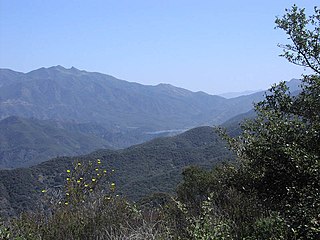
The California chaparral and woodlands is a terrestrial ecoregion of southwestern Oregon, northern, central, and southern California and northwestern Baja California (Mexico), located on the west coast of North America. It is an ecoregion of the Mediterranean forests, woodlands, and scrub biome, and part of the Nearctic realm.

Salvia mellifera is a small, highly aromatic, evergreen shrub of the genus Salvia native to California, and Baja California, Mexico. It is common in the coastal sage scrub of Southern California and northern Baja California. Black sage has a dark appearance, especially during drought.

Salvia apiana, the Californian white sage, bee sage, or sacred sage is an evergreen perennial shrub that is native to the southwestern United States and northwestern Mexico, found mainly in the coastal sage scrub habitat of Southern California and Baja California, on the western edges of the Mojave and Sonoran deserts.

The Coronado Islands are a group of islands located 13 km (8 mi) off the northwest coast of the Mexican state of Baja California. Battered by the wind and waves, the rocky islands are mostly uninhabited except for a small military detachment and a lighthouse keeper. Despite their barren appearance, they serve as a refuge for seabirds and support a sizable number of plants, including 6 endemic taxa found only on the islands. The waters around the islands support a considerable amount of diverse marine life.

The Northern California coastal forests are a temperate coniferous forests ecoregion of coastal Northern California and southwestern Oregon.
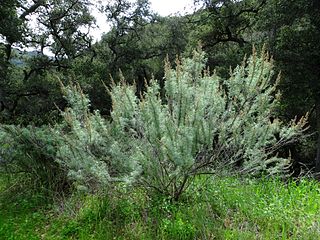
Artemisia californica, also known as California sagebrush, is a species of western North American shrub in the sunflower family.

Agave shawii is a species of monocarpic succulent plant in the genus Agave, commonly known as Shaw's agave. It is a rosette-forming plant characterized by glossy, green leaves with toothed margins. After several years of slow growth, the plant puts all of its resources to produce a towering stalk of flowers, and then dies. The death of the flowering rosette is compensated by the growth of numerous clonal pups. This species is segregated into two subspecies, one native to the coast of southwestern California and northwestern Baja California, known commonly as the coast agave, and another native to the Baja California desert, known as the Goldman agave.
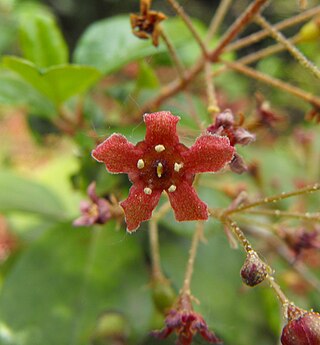
Ribes viburnifolium, is an uncommon North American species in the gooseberry family. It is known by the common names Catalina currant, Santa Catalina Island currant, island gooseberry and evergreen currant.

Malosma is a plant genus which contains only a single species, Malosma laurina, with the common names laurel sumac and lentisco (Spanish). Malosma laurina is found along the southern California and Baja California coasts of the Pacific Ocean.
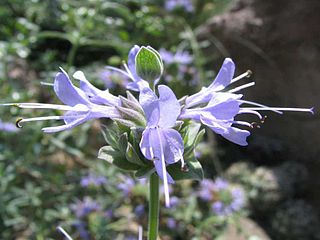
Salvia clevelandii, the fragrant sage, blue sage, Jim sage and Cleveland sage, is a perennial plant that is native to Southern California and northern Baja California, growing below 900 m (3,000 ft) elevation in California coastal sage and chaparral habitat. The plant was named in 1874 by Asa Gray, honoring plant collector Daniel Cleveland.
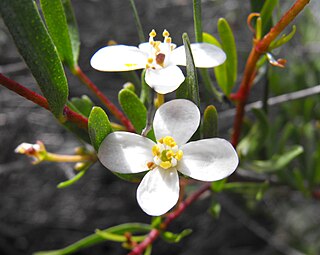
Cneoridium is a monotypic genus in the citrus family which contains the single species Cneoridium dumosum, commonly known as bushrue or coast spice bush. As a perennial, evergreen shrub, Cneoridium is native to the coast of southern California and Baja California, thriving in hot, dry conditions. This plant is characterized by a distinctive citrusy aroma and small, white flowers that appear from winter to spring. The flowers eventually become round berries that resemble a miniature version of the common citrus.

Euphorbia misera is a semi-succulent shrub in the genus Euphorbia commonly known as the cliff spurge or coast spurge. A drought-deciduous shrub, it is typically found as a gnarled, straggly plant occupying seashore bluffs, hills and deserts. Like other members of its genus, it has a milky sap, which can be found exuding out of the light gray bark when damaged. The alternately-arranged leaves are round and folded in the middle, with small hairs on them. The "flowers" can be found blooming year-round, and are colored maroon or yellow in the center with 5 white to light-yellow petal-like appendages attached outside. This species is native to the Baja California peninsula and Sonora in Mexico, and the coast of southern California in the United States, where it is a rare species. It is threatened in some localities by the development of its coastal habitat, which tends to be prime locations for high-end residential and commercial developments.

Adolphia californica, known by the common names California adolphia, California prickbush, and spineshrub, is a species of flowering shrub in the buckthorn family.

Salvia brandegeei is a perennial evergreen shrub in the mint family known by the common names Santa Rosa Island sage or Brandegee's sage. It is a fragrant plant characterized by lavender flowers and dark green leaves. For many years, it was thought to be native only to Santa Rosa Island, one of the Channel Islands of California, until it was discovered along the coast of Baja California. It is threatened by development and mining along the mainland portions of its range, but otherwise has a stable population on Santa Rosa Island.

Ceanothus verrucosus is a species of shrub in the family Rhamnaceae known by the common names wart-stem ceanothus, barranca brush, coast lilac and white coast ceanothus. It is endemic to northwestern Baja California and San Diego County, where it grows in coastal sage scrub and coastal succulent scrub habitats. It is considered a rare species north of the international border, as most of the valuable coastal land that hosts this plant in the San Diego area has been claimed for development. In California, several extant populations still remain scattered around the region, such as one protected at Torrey Pines.
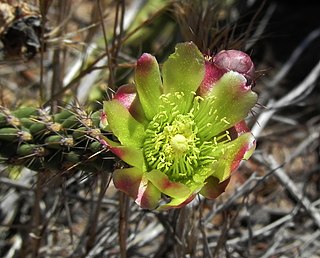
Cylindropuntia californica is a species of cholla cactus known by the common name snake cholla. It is primarily found in Baja California, Mexico and the southernmost part of California in the United States. It is characterized by a short, decumbent habit, yellow-green flowers, elongated stems, and short spines. It is mostly found in coastal sage scrub and coastal chaparral habitats, but two varieties in Baja California can be found in foothills and deserts. In California, variety californica is regarded as a rare and threatened plant, with a California Native Plant Society listing of 1B.1, in part due to its limited number of occurrences and threats from development. It formerly was considered to have a larger range due to the inclusion of Cylindropuntia bernardina within it as the variety parkeri.

The California coastal sage and chaparral is a Mediterranean forests, woodlands, and scrub ecoregion located in southwestern California and northwestern Baja California (Mexico). It is part of the larger California chaparral and woodlands ecoregion.

Salvia munzii is a semi-evergreen perennial species of sage known by the common name Munz's sage or San Miguel Mountain sage. It is native to northern Baja California, Mexico, and it can be found in a few locations just north of the border in San Diego County, California, where it is particularly rare. It is characterized by small leaves and clear blue flowers. It is a member of the coastal sage scrub and chaparral plant communities.























